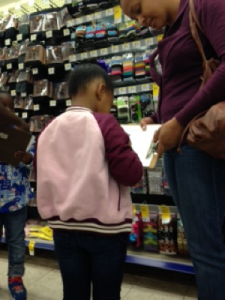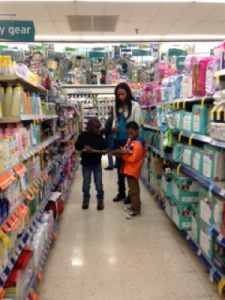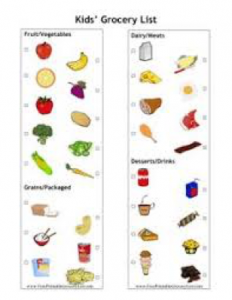Taking a trip to the store
 November means many trips to the grocery store, getting food for Thanksgiving, buying extra snacks and dinner for out of town guests. And on top of that, the kids are home for break. A quick or long trip to the grocery store can be a great learning experience for children of all ages, not just school aged children.
November means many trips to the grocery store, getting food for Thanksgiving, buying extra snacks and dinner for out of town guests. And on top of that, the kids are home for break. A quick or long trip to the grocery store can be a great learning experience for children of all ages, not just school aged children.
A lot of classrooms use the idea of stores in the dramatic play area because it is such a great way to build literacy and math skills and all kids have been to a type of store whether it is a grocery store, pharmacy or toy store. Children can make lists of foods, think about prices, begin to learn the importance and the types of money used to buy materials. Some children can even graduate to doing simple math problems using money. And all children enjoy collecting money and using a cash register, which is basically a calculator. Reinforcing these math concepts at home can only strengthen children’s understanding of math, since parents are the child’s first teachers!
 Here are some quick and easy tips for how to turn grocery shopping into a fun game.
Here are some quick and easy tips for how to turn grocery shopping into a fun game.
- Before going to the store, sit down with your child and make a list. Give them a pencil or crayon and a piece of paper and let them write their own list. Number the list, so the children can see the sequence of numbers. Ask them, ‘what number comes after 1, 2, 3?” You can also have them sort the items you need, make a list of vegetables, fruit, meat, etc. Grocery stores are a great lesson on sorting and understanding categorizing items based on an attribute.
- While making the list have your child guess how much each item will cost. Do they think it will cost more because of its size? Or because of how much the item weighs. Then when you get to the store, you can compare their guesses with the actual prices.
- Have your child help you weigh fruits and vegetables in the produce sections. Begin to introduce words like: pound, ounce, more than, less than, equal.
4. Print out a shopping checklist and attach it to a clipboard.  Let your youngest child mark off each item as you find it. Throughout the trip, bring their attention back to how many items you have found and how many items you have left.
Let your youngest child mark off each item as you find it. Throughout the trip, bring their attention back to how many items you have found and how many items you have left.
5. If it is a store you frequent often, draw a map of the store and give to your child. Give them directional cues, like, “turn left at the produce aisle.” Or have them fill in the map using developmental spelling or drawing pictures.
6. Give your child $5 and ask them to pick out snacks. They might need some help adding up totals and limiting themselves to only spending $5, but this is simple addition and subtraction problems without using a worksheet and disguised as fun! My classroom walked to our local Walgreens and they each had to find an item that cost less than a dollar.  For some, it was a rude awakening that they couldn’t buy the biggest or best item in the store, but in the end everyone walked away with a small treat!
For some, it was a rude awakening that they couldn’t buy the biggest or best item in the store, but in the end everyone walked away with a small treat!
you can also have them notice different weights like dry goods vs can goods.
This is also an opportunity to discuss healthy and non healthy foods.
I think this is a great way to apply learning skills, it can be adjusted to many different age levels.
very interesting
What a great learning tool! not only can Students learn, but also using this with your own children or children in the family to help them learn as well the value of Money.
This air help the children learn pounds, ounces. Also teach them how much each item cost, and the value of money.
Totally enjoyed reading this lesson. I am going to incorporate a few things in my kitchen center, like a dry erase grocery list using pictures and also add our weigh scale so they can weigh their food. I like the idea of turning my kitchen space into a grocery store, I’m gonna see how I can do that. So many learning opportunites!
Real life skill learning starts young!
Real world applications are the most meaningful. Also the grocery list is great for literacy.